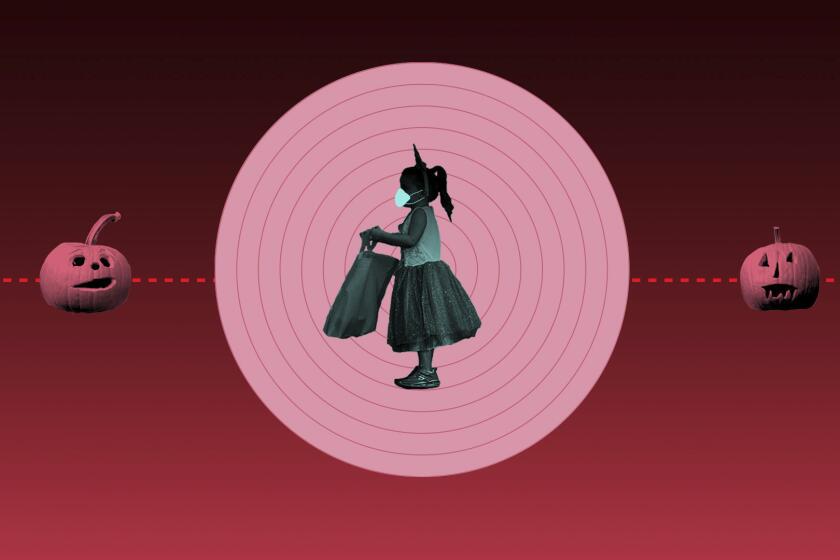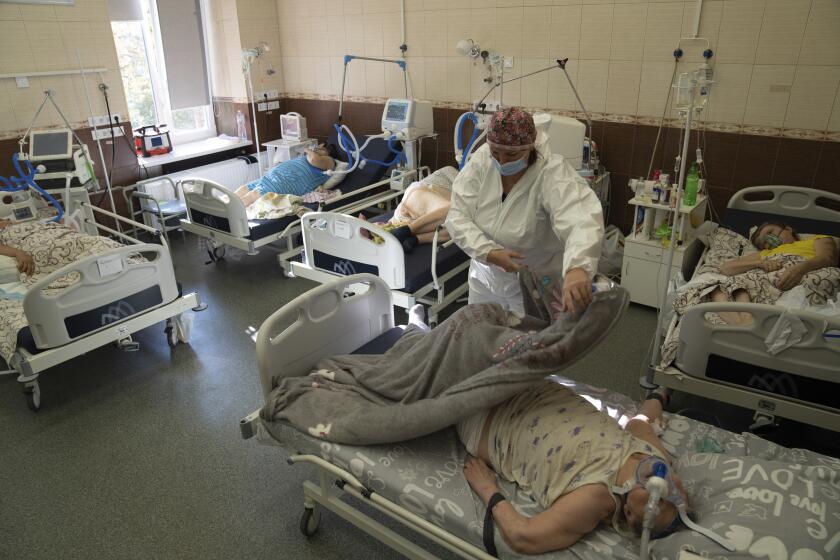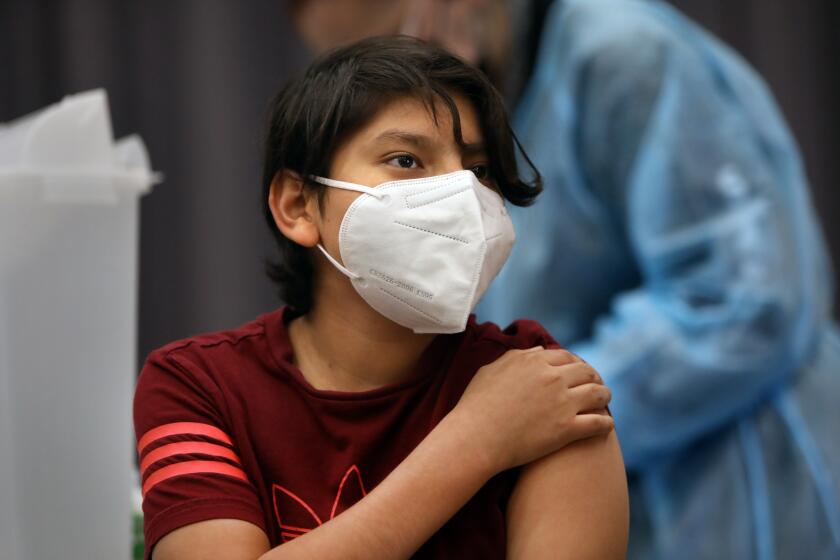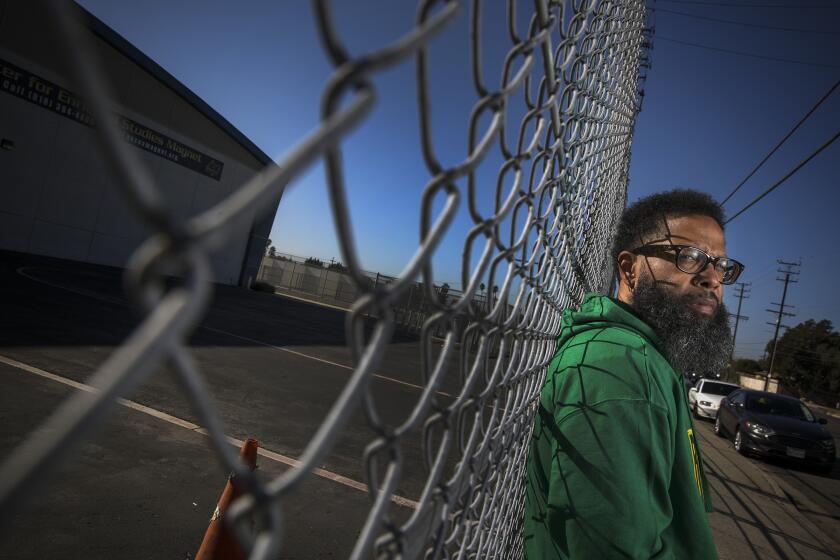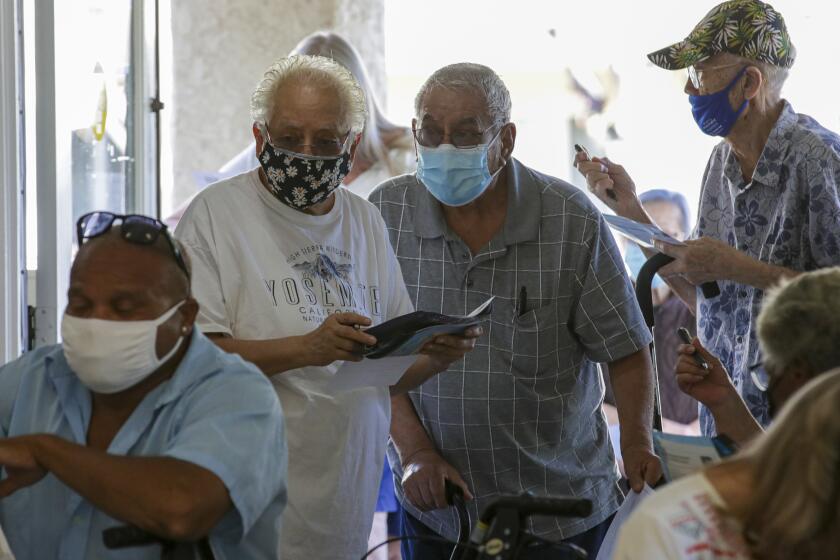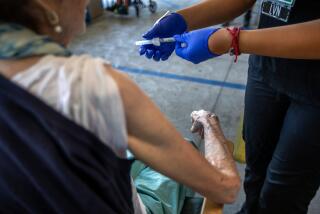After months of decline, coronavirus cases plateau in California. Can we avoid a new surge?

After months of significant declines, California’s new weekly coronavirus cases and hospitalizations have plateaued just as the critical holiday season approaches.
The state’s coronavirus transmission rate has long been among the lowest in the country, and officials hope vaccine requirements and other safety rules will prevent another spike in cases and deaths this winter.
But the arrival of Halloween will kick off a packed slate of fall-and-winter festivities, tempting many residents to travel and gather in numbers not seen since before the pandemic.
Combine that with cooler weather increasingly pushing activities indoors — where the risk of transmission is generally higher — and the apparent seasonality of COVID-19 itself, and there’s potential for this latest lull to be a launching point for a new influx of infections.
Even though California continues to fare better than most states, it’s still considered to have “substantial” transmission — the second-worst category in the U.S. Centers for Disease Control and Prevention’s four-tier scale.
Whether you let your children go trick-or-treating during the pandemic will depend on your situation and comfort level.
When the state celebrated its full economic reopening in mid-June, California was reporting fewer than 1,000 new coronavirus cases a day. Now, the state is seeing between 5,000 and 6,000, on average.
And about 100 Californians are still dying of COVID-19 every day. Before the Delta variant surge, California was reporting about 25 deaths a day.
Dr. Regina Chinsio-Kwong, an Orange County deputy health officer, has been warning for weeks that a pandemic uptick was possible as the weather cools if vaccination rates do not drastically improve. In mid-October, she pointed to the experience of the United Kingdom, which at times has foreshadowed the direction the U.S. has headed.
“As the winter months come up and as all of these holidays come up, more people are going to gather and more people are going to be indoors,” Chinsio-Kwong said. “So if we don’t take precaution until everybody gets some sort of immunity, we are still at risk of continuing to have higher numbers in case rates, similar to the United Kingdom.”
California is not necessarily destined to follow Britain’s path. It’s possible that a combination of the state’s relatively high immunization rates, along with a higher rate of natural immunity, could position it to weather this fall and winter better than other places.
But the state has, for now, stopped recording week-over-week declines in coronavirus cases and COVID-19 hospitalizations. And the rate at which coronavirus test results are coming back positive has crept up.
“Across California, our state is open and we do realize that people are getting tired of wearing masks and that there is also waning immunity. And there’s many more in our community who are still not yet vaccinated,” Chinsio-Kwong said Friday. “So yes, as people go indoors, we expect that cases will either stay at the same rates or may actually increase.”
On Thursday, California reported 3,816 people with COVID-19 infections in hospitals statewide, a 4% increase from a week earlier.
The latest hospitalization numbers are nowhere near the height of the summer surge, which peaked with 8,353 patients Aug. 31. But it’s still quadruple the level before the Delta surge.
“We have certainly seen a downsizing of the surge that we had, but cases are flattening out and we’re not seeing any further decline. Things have been pretty stable over the last couple of weeks,” said Dr. Marty Fenstersheib, the vaccine officer for Santa Clara County, Northern California’s most populous. “We hope that this is not the beginning of a surge.”
The statewide test positivity rate over the last seven days is now 2.8%, up from 2.1% a week ago.
And after dropping steadily for weeks, the number of new daily coronavirus cases has leveled off. For the seven-day period that ended Thursday, there were 6,068 new cases on average each day across California. That’s up 10% from the previous week.
Ukraine and other Eastern European countries are experiencing a surge in COVID-19 infections and deaths as many residents resist getting inoculated.
The arrival of last year’s holiday season spelled disaster for California, ushering in a ferocious coronavirus wave that pummeled the state.
“I want to be sober about the moment we’re in because, in many ways, it’s reminiscent of where we were last year,” Gov. Gavin Newsom told reporters Wednesday.
But he also acknowledged “the progress we’ve made, because we should, and I want to thank 40 million Californians for their resilience.”
Much is different this year than last — including the introduction of vaccines — and health experts and officials generally think California is unlikely to experience the same turmoil.
But COVID-19’s trajectory is well-known.
Gatherings, particularly in crowded indoor settings, provide ample opportunity for transmission. Health officials also “now believe there’s some seasonality to COVID that may make it easier for there to be spread during the colder months,” Los Angeles County Public Health Director Barbara Ferrer told reporters Thursday.
State officials are preparing to offer COVID-19 vaccine doses to California’s 3.5 million children ages 5 to 11 as soon as the end of next week.
As of Thursday, Orange County was reporting, on average, 279 new coronavirus cases a day over the last week, an 18% increase from a week ago. Los Angeles County’s seven-day average of 1,224 new coronavirus cases a day is up 23% from a week ago.
More than 60% of residents of all ages in both L.A. and Orange counties are fully vaccinated, according to data compiled by The Times.
But even in the San Francisco Bay Area, home to the state’s highest vaccination rates, some officials have reported that cases are no longer decreasing.
More than 70% of all residents in Santa Clara County are believed to be fully vaccinated, yet officials there are also seeing progress stall, with new average cases generally hovering around 150 a day throughout October. In June, Santa Clara County was generally reporting about 30 cases a day.
In Fresno County, the recent improvement in COVID-19 hospitalizations has begun to evaporate. After peaking at 410 before Labor Day, the number of hospitalized patients in the San Joaquin Valley’s most populous county fell to 240 by mid-October but has rebounded above 300 in recent days.
Fresno County’s per capita COVID-19 hospitalization rate is five times worse than L.A. County’s and one of the worst in California.
“It’s actually a somewhat bleak outlook,” said Dr. Rais Vohra, Fresno County‘s interim health officer. “Hospitals may actually experience the same level of stress and strain that they had with this last fall surge or last winter surge.”
Too few people have gotten their shots — only a little over 50% of residents are fully vaccinated — and too few have received boosters, Vohra said. “And we’re already starting with an extremely impacted healthcare system.”
Most of California remains in the worst two categories of the coronavirus transmission scale — either “substantial” or “high” as defined by the CDC. Los Angeles, Orange and Ventura counties had “substantial” transmission as of Friday, while San Diego, Riverside and San Bernardino counties were rated “high,” the worst category.
And several counties were reclassified into worse categories Friday: Alameda, San Mateo and Monterey moved from “moderate” to “substantial,” and San Luis Obispo moved from “substantial” to “high.”
The overall risk for kids is small, but COVID has become a leading cause of death for children, making vaccination as important as ever, experts say.
While healthcare systems are no longer stretched to extremes, officials say they could be stressed by another, more familiar foe in the coming months: the flu.
The nation was spared the typical flu season last year — a development experts credited largely to measures to combat the coronavirus, such as wearing face coverings, practicing social distancing and avoiding crowded settings.
That’s not expected to be the case this year, though. Businesses that were closed or severely limited last year are now operating at full capacity. Sporting events and concerts have resumed. And many residents are expected to travel to see family and friends.
The prospect of flu season arriving amid continued high coronavirus transmission is so concerning that it’s even spawned a moniker: a “twindemic.”
“We know that there’s other respiratory viruses that are beginning to circulate, the flu and other ones, impacting both young people and adults,” said Dr. Mark Ghaly, California’s health and human services secretary. “We are worried that this will continue to have a challenge on our hospital system, and that certain efforts to really protect California are going to need to be doubled down on so that we can get through the next few weeks and months.”
All these school workers were willing to give up their jobs rather than submit to a COVID-19 vaccination.
Many are confident that California is better equipped to weather a COVID-19 storm this year, thanks, especially, to the widespread availability and deployment of vaccines, which officials and experts say continue to offer strong protection against infection and severe disease.
According to state data, unvaccinated Californians are seven times likelier to be infected, 10 times more likely to wind up hospitalized and 15 times more likely to die than their vaccinated counterparts.
Already, nearly 69% of all Californians have received at least one dose, and about 62% are fully vaccinated. The inoculation campaign soon could get an extra boost when state and federal health officials extend vaccine access to children 5 to 11. Doing so will make an additional 9% of California’s population eligible for the shots.
Still, that coverage is well short of the level thought necessary to provide lasting protection against future outbreaks.
Even if just 32% of Californians are unvaccinated at this point, that‘s still more than 12 million people. That’s larger than the population of all but six states.
Federal health officials aren’t giving any specific recommendations, but there are options for COVID-19 boosters, and it’s OK if you mix vaccines.
And last year’s fall-and-winter surge proves just how quickly the virus can spiral out of control.
On Oct. 21, 2020, the state reported about 3,000 new cases, Times data show. A month later, there were 12,100. And a month after that, the daily reported total had swelled to 58,400.
Community transmission didn’t fall back to pre-surge levels until March.
“We enter into these next many weeks confident in the state of play with vaccines and their ultimate protection of so many, but cautious and vigilant with our guard up to make sure that our hospital system is prepared, our public health system messages and measures are in place, so that we can make sure California gets through what was a very tough period last year,” Ghaly said.
More to Read
Start your day right
Sign up for Essential California for news, features and recommendations from the L.A. Times and beyond in your inbox six days a week.
You may occasionally receive promotional content from the Los Angeles Times.
